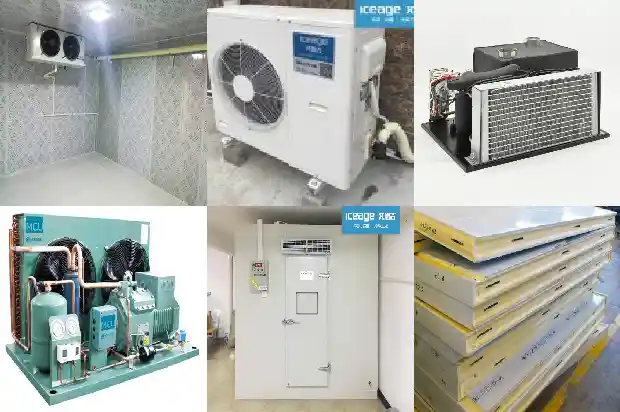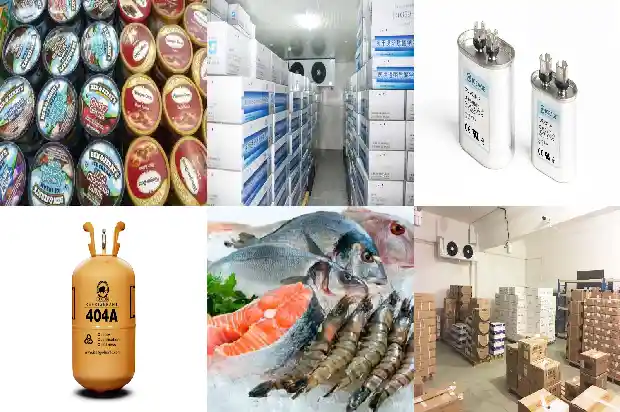Matters Concerning the Installation of Parallel Units
2025-03-01
A refrigeration device with multiple compressors assembled in parallel on a single base frame is called a parallel compressor unit.
I. Inspection Work before Installation:

I. Inspection Work before Installation:
- First, check whether the model of the unit is consistent with the ordered model. In the model identification of the parallel units of most manufacturers, information such as the unit frame type, the number of compressors, the unit horsepower, the number of compressor stages, the temperature range, the type of lubricating oil used, the type of refrigerant, and the optional accessories are included.
- Among the goods shipped together with the unit, the condenser matched with the unit is often included. Check whether the model of the condenser is consistent with the ordered model. The model identification of the condenser generally includes information such as the condenser type, the nominal heat dissipation capacity, the number of fans, the fin condition, and the number of motor poles.
- The unit is pre-charged with dry nitrogen to maintain pressure before leaving the factory and the pressure value is marked on the pressure gauge.
When receiving the goods, check whether the marked value is consistent with the value displayed on the dial, that is, check whether there is a pressure drop in the unit. If the pressure drops or disappears, contact the manufacturer immediately.
- The accessories of the unit, such as the drying filter element and the vibration damping pad, are generally packaged separately in an accessory box. Check and accept them according to the packing list.
II. Precautions for Equipment Hoisting and Installation: - For the parallel units with a heavy-duty frame (such as the frame welded with profiles like square tubes and channel steels), since the part bearing the hoisting load is only the channel steel base connected by welding, the unit is only allowed to be hoisted in two ways: directly fork the base with a forklift or connect the lifting lugs at the four corners of the frame with rigging. And the rigging is not allowed to touch any pipes or electrical components of the unit during hoisting. For the parallel units with a light-duty frame (the frame processed with sheet metal parts and connected by bolts), most of them have holes specially designed for inserting the forks of the forklift at the bottom of the unit. When forklifting, pay attention that the vertical surface of the fork does not touch or squeeze the components on the unit (especially the electrical control box, the display screen, etc.).
- The ground foundation for installing the parallel compressor unit should meet the following basic requirements:
2.1 The foundation and the base should have sufficient stiffness to avoid excessive deformation, cracking, or tilting under the load. The foundation should not produce excessive vibration under the action of the disturbing force, so as not to affect the normal operation of the unit itself and the normal use of the adjacent equipment. Generally, the foundation is a horizontal reinforced reinforced concrete floor about 152mm thick.
2.2 To meet the basic requirements of the equipment foundation, static and dynamic calculations should be carried out on the foundation according to different disturbing force conditions. In the design, it should be analyzed and calculated according to national standards, and the following key points should be noted:
a) Avoid the resonance of the base group: When the base group resonates, the amplitude of the foundation will increase greatly, affecting the normal operation of the equipment and the surrounding equipment. At the same time, the force on the foundation will also increase, which may lead to unacceptable settlement of the foundation.
b) Reasonably select the type and size of the foundation.
c) Prevent the foundation from settling unevenly. - Unit Placement Location: The parallel compressor unit should be installed horizontally in the machine room, and the installation should be considered to make daily maintenance as convenient as possible. At the same time, it should also comply with local fire protection requirements and building code requirements. Generally, the minimum clearance between the unit and other objects or walls is as follows: a back spacing of 600mm, at least 1100mm spacing in front of the panel. For multiple units arranged in a row, it is recommended that the spacing between the units be greater than 610mm. The placement location of the unit or the condenser should be as far as possible from the areas that require absolute quietness. The unit should be as close as possible to the evaporator (display cabinet or cold storage, etc.).
- Equipment Vibration Isolation: Usually, the accessories shipped with the unit by the manufacturer include vibration damping pads for the user. Installing vibration damping pads on a common ground or foundation can achieve a good vibration isolation effect. It is generally not recommended to use the installation method of fixing the unit with embedded bolts. If the user must use the method of embedded bolts to install the parallel unit, then the unit and the embedded bolts cannot be rigidly fixed (that is, the expansion bolts cannot be tightened).
- The Condenser Placed Separately from the Unit: The platform or foundation for installing the outdoor condenser should also be kept horizontal, and the location should have good free ventilation. It is absolutely not allowed to place the condenser in an area adjacent to the emission of steam, hot air, or flue gas. Avoid phenomena such as skewing, uneven force, and vibration transmission. There should be no obstacles in the space in the direction of the air discharged by the fan of the condenser, and the air discharged by the condenser must not encounter obstacles and recirculate back to the air intake side of the condenser. At the same time, enough space should be reserved for the maintenance and upkeep of the condenser.
- Ventilation Requirements of the Machine Room: In most cases, the parallel compressor unit will be placed in the machine room. The machine room should ensure sufficient ventilation to avoid excessive internal temperature, especially during the high-temperature period in summer when the load is large and the temperature is high. The parallel compressor unit with a split condenser must rely on ventilation to take away the excess heat. Air inlets can be set to allow natural air to flow through the unit.
Related Articles
- Advanced Guide! Design and Installation of Refrigeration System Pipelines
- What Are the Acceptance Standards for Cold Storage Design and Installation?
- What issues should be noted during the installation of a small - scale cold storage?
- Instructions for Welding and Drainage in the Installation of Refrigeration Equipment Pipelines
- What is the Correct Operation Method of the Distribution Box during Cold Storage Installation?
- What Issues Should Be Noted in Cold Storage Installation and Construction?
- What Special Requirements are There for the Installation of Tea Cold Storage?
- Operating Principle and Standard Installation Steps of Multi - split Systems in Refrigerant Air - conditioning Systems
- How to Identify the Quality of Refrigeration Equipment Installation Materials?
- How to Identify Installation Materials for Refrigeration Equipment
- Knowledge, Installation and Maintenance of Cold Storage Systems
- Precautions for the Installation and Use of Water Flow Switches
- What safety measures should be paid attention to during the installation of cold storage?
- What are the precooling methods after the installation of cold storage?
- Selection and Installation of Thermal Expansion Valves
- Return Bend Setup and Installation Technical Requirements
- Daily Maintenance Training for Users after Installation of Small and Medium-Sized Cold Storages
- Parallel Installation and Precautions for Scroll Compressors
